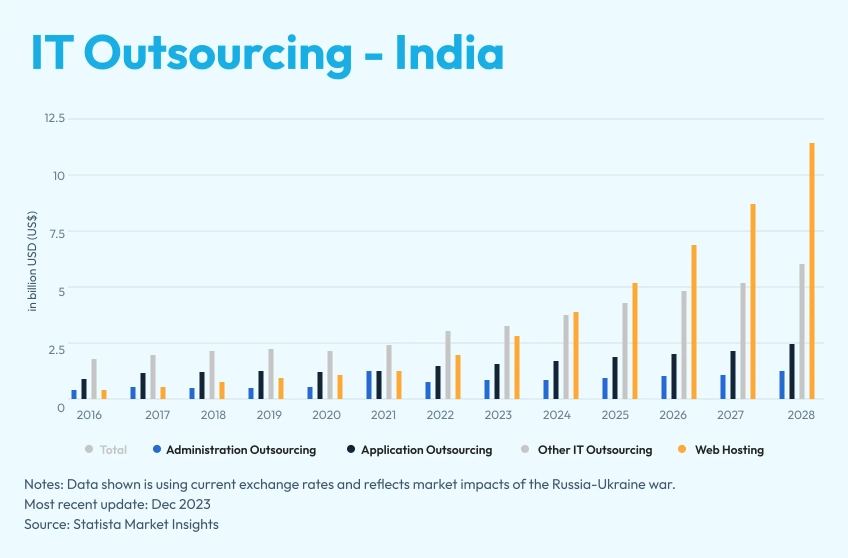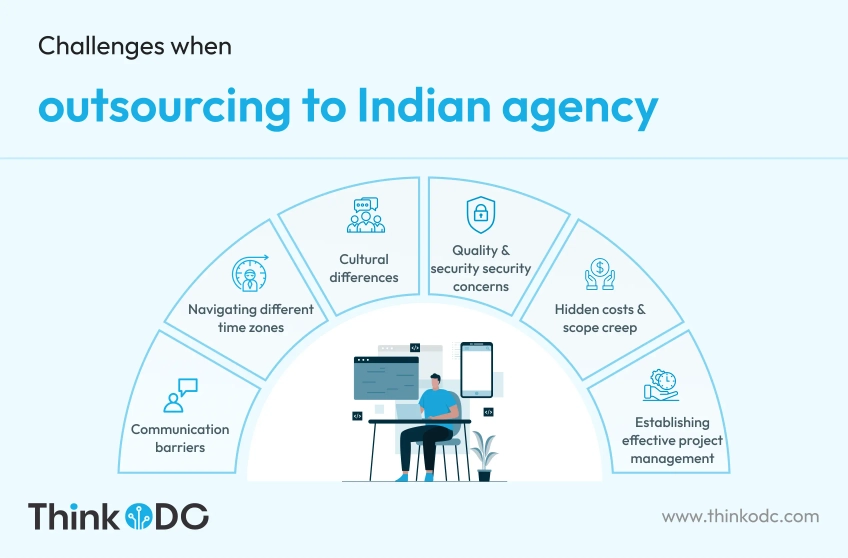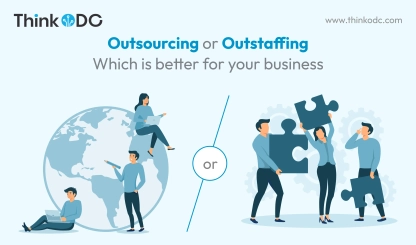Are you considering outsourcing some of your tech or IT work to an Indian IT agency?
Good choice!
With an abundance of skilled engineers and developers, as well as lower wages, it has become a top outsourcing destination for many businesses.
As per Statista, the IT Outsourcing market in India is expected to generate US$8.81 billion in revenue in 2023, with a compound annual growth rate (CAGR) of 17.92% from 2023 to 2028, reaching a market size of US $20.09 billion by 2028.
This indicates that the IT outsourcing industry in India is not only thriving but is also projected to experience substantial growth in the coming years.

However, some organizations have run into troubles when outsourcing work overseas.
In this post, we will talk about some of the most common challenges that come up when outsourcing to Indian IT companies and provide some practical tips for how to tackle them.

So here we go:
Communication barriers
One of the biggest issues that comes up time and again with outsourcing IT to India is good old-fashioned miscommunication. Whether it's language gaps, unfamiliar accents and speech patterns, or even just differences in communication styles, messages can too easily get lost across cultural and geographic divides.
On top of spoken language barriers, technical terminology and documentation passed back and forth also may not be clearly understood between teams. And even non-verbal cues like body language and facial expressions that we take for granted during in-person interactions are absent in remote communication.
All of these factors can lead to misunderstandings, the wrong expectations being set, frustration over having to repeat requests multiple times, and delays that hamper project timelines.
So what can be done to set expectations and smooth out communication flows? A few ideas:
-
Use clear, simple language when documenting requirements and specifications. Avoid overly complex sentences or industry jargon that might not translate well.
-
Schedule video calls, so teams can see facial cues and on-screen body language instead of just disembodied voices.
-
Invest time upfront in cultural training so both sides better understand communication norms and can clarify potential confusion points early.
-
Hire a bilingual project manager or coordinator familiar with both Western and Indian business cultures who can serve as a conduit between the two teams.
The keys are focusing on active listening, creating space for clarification questions, and bridging potential culture gaps through empathy and understanding. Patience and thoughtful communication pave the way.
Navigating different time zones
Another huge logistical consideration is the time zone difference between the US/Europe and India. With India being 9-12 hours ahead, there is minimal overlap between normal business hours. This can cause major headaches when trying to collaborate in real time.
Deadlines can be missed, approvals delayed, and meetings become difficult (if not impossible) to schedule.
There are a few strategies that can optimize collaboration despite the physical distance:
-
Establish a few hours of required online overlap, where both teams commit to being simultaneously available for video meetings and calls.
-
Set expectations upfront for reasonable response times to requests and questions. 24 hours may be needed to accommodate each team's core focus hours.
-
Management tools and asynchronous platforms keep work moving forward even outside overlapping hours through documented task lists, progress reports, discussion threads, file sharing and more.
-
Be very clear about looming deadlines, status updates needed by certain dates, and any other time-sensitive communication required to keep projects on target.
While the gap in time zones will always provide logistical hurdles in distributed team management, being intentional about the cadence, tools, and availability expectations can help minimize disruption.
Cultural differences
India, similar to any country, has very distinctive cultural traits that shape personal values, communication norms, work styles, business etiquette, and more.
Western cultures can sometimes clash with aspects of Indian culture and cause tension in collaborative projects.
For instance, attitudes towards hierarchy, conflict avoidance, indirect means of providing negative feedback, discretion in decision-making processes, consensus building, and confrontation vary greatly between cultures and individual preferences.
Cross-cultural blunders or faux-pas can unintentionally offend team members creating detachment, anxiety, lack of motivation or avoidance behaviors.
What’s the remedy here? Mostly awareness, active learning, and patience.
-
Recognize that differences exist, without assigning value judgements to cultural tendencies. Be curious rather than critical.
-
Through open dialogue and shared experiences over time (like celebrating Indian holidays relevant to the teams), cultural intelligence increases on both sides.
-
Display grace and understanding when misalignment occurs, rather than frustration or blame. Approach interactions with modesty rather than assumptions.
-
Establish group norms that allow for indirect communication without demanding uncomfortable directness. Also, provide space for styles like reflection before response.
-
Implement project management rituals that encourage clarity. For example, summarizing action items after meetings and documenting decisions.
While cultural alignment takes time, the rewards of increased empathy, resonance and collective ownership make it well worth the investment.
Quality and security concerns
Outsourcing critical company technology, systems or product development also comes with rightful concerns around protecting IP assets as well as receiving quality outputs.
How can you verify the credentials, capabilities and integrity of a potential Indian IT outsourcing partner?
Questions inevitably come up about security holes, inexperienced teams, inferior code quality, hidden instability, data breaches and more. No business leader wants to have major vulnerabilities introduced or shift the technology debt burden as a result of outsourcing.
Due diligence takes on amplified importance for offshore engagements where direct oversight is limited. Thoroughly vetting offshore outsourcing team is essential:
- Verify industry credentials, certifications, client lists and reviews. Ask for referrals from past customers.
- Clearly scope out project deliverables, success metrics, quality standards, documentation needs, testing protocols, security requirements, compliance controls and confidentiality agreements.
- Implement secure data, asset transfer and access management controls. Establish IP rights and licensing upfront.
- Schedule code reviews, routine performance checks and structured testing regimens into the outsourcing process. Be proactive with constructive feedback and direction.
- Conduct periodic risk assessments and keep vigilant for potential holes or issues. Have contingency plans in place if quality lapses occur.
Staying continually engaged, maintaining transparent dialogue around objectives and keeping structured oversight measures in place helps safeguard quality assurance and risk management when outsourcing key technology outside the company walls.
Read More: Benefits of outsourcing mobile app development to India
Hidden costs and scope creep
Another area we often see trip-up outsourcing initiatives is exploding budgets due to creeping scopes and unexpected costs. Outsourcing often initially promises notable cost savings, but reality doesn’t always match the vision.
It might start as a well-defined project with a modest price tag. But due to shifting requirements, Communication gaps, and misaligned understanding around deliverables between client and vendor, suddenly you wake up to multiplied hours, cost overruns and rushed delivery as a deadline looms. Frustration builds on both sides.
What contributes to this dynamic?
- Lack of clear documentation, leading to different work expectations
- Insufficient conversations clarifying assumptions and decision rights upfront
- Poor change control as requests expand without visibility by management
- Weak governance allows new features or services beyond the budget
- Invoices with vague descriptions or surprise expenses
- Incentive for vendors to increase profits by expanding work efforts
Controlling costs starts at the contracting phase and continues through disciplined project management:
- Whenever possible, negotiate fixed pricing tied to milestones to cap expenses
- Build check-in points around scope changes before allowing increases
- Establish consistent invoicing cadence with clear expectation-setting
- Maintain diligence tracking budget burn rates and variances
- Allow for buffer amounts to absorb some shifting requirements
- Create transparency by documenting requests and approvals needed
- Push back firmly against excessive cost inflation due to uncontrolled changes
Budget discipline requires saying no when mission creep threatens the bottom line. But good partnerships also enable flexibility when value aligns. Find the balance through open finance tracking and containment governance.
Establishing effective project management
One of the most useful ways to circumvent many of these outsourcing obstacles comes down to governance - having the right project management practices in place to align activities between globally dispersed teams. When structured communication processes falter, things predictably go sideways.
Make sure to have:
- Dedicated project managers on both teams responsible for requirements gathering, documentation, daily standups, obstacle resolution and partner coordination.
- Regular meetings, status reports, project planning sessions and tool-based workflows. Identify key talking points.
- Visible tracking of action items, decisions, risks, dependencies and budget actuals through project management platforms.
- KPIs measure success metrics like system uptime, help ticket resolution rates, adoption levels etc.
- Unified understanding of issue escalation procedures for when problems arise. Document comprehensively.
- Continual touchpoints between managers during development sprints for commentary and needed course corrections.
Strong project oversight ties all the above people, process and technology considerations together to enable outsourcing productivity. And bridges the common pitfalls.
Wrapping up
Successful outsourcing to India requires effort but brings enormous gains - talented resources, and accelerated growth. By establishing robust engagement models encompassing clear contracts, stringent progress evaluations and collaborative decision-making, outsourcing can yet unlock innovation at lower costs!
With some diligence, empathy and trust - these partnerships can reap rich dividends. Because beyond roles as clients and outsourcers, we’re all partners pursuing growth together.
Why outsource to ThinkODC?
When considering outsourcing to an Indian IT agency for your software development needs, ThinkODC stands out as a premier choice. With over 12+ years of experience helping global companies build innovative solutions, ThinkODC leverages India’s vast pool of engineering talent to deliver quality work, cost-efficiency, and flexible scaling.
Our teams blend strong technical capabilities across the latest technologies with stellar communication skills and cultural alignment. ThinkODC also invests heavily in long-term partnerships, ensuring transparency and trust stand central to engagements.
Through robust quality assurance, project transparency, and demonstrated expertise across industries, ThinkODC reduces delivery risk so you can launch products faster. Our proven frameworks accelerate development cycles while keeping you fully informed to meet strategic goals





